
How to Write a Summary for Essays, Articles, and Books
As you’ve already guessed, today’s blog post is the ultimate guide on how to write a summary for different papers.
Not only will you learn about four academic summary types, their purpose, and their proper formatting, but you’ll also master the art of summary writing step by step and get answers to all the frequently asked questions on the topic.
Here we go! (It won’t take much time, we promise.)

Table of Contents:
What is a Summary?
In plain English, it’s a brief paragraph summarizing a bigger work: an article, a scientific paper, a book, a movie’s plot, etc. The purpose is to give the reader a comprehensive understanding of the asset:
You gather the main ideas of an essay, a book, a film, etc., and provide the overview for the reader to know what it’s about. You mention critical details and information there but avoid sharing your personal opinion about the work.
It’s also critical to understand the difference between a summary and an abstract:
An abstract is a summary type, used when writing academic texts like theses, dissertations, and research journal articles. It summarizes the whole text in the very beginning. Like this:
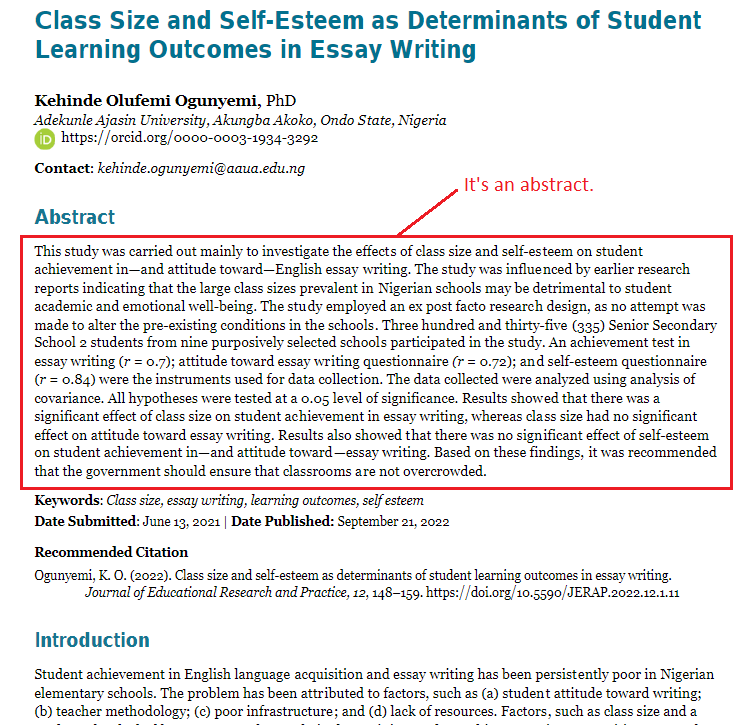
A summary works elsewhere in academic writing:
It can be a stand-alone assignment or a part of your essay, book critique, literature review, annotated bibliography, etc.
When writing an academic paper, summaries can be your way to integrate sources: Besides using quotes or paraphrases from the original text, you can provide an overview of the whole text before analyzing it.
Below is an example of a summary overviewing this work:
Using national survey data, Davis et al. (2015) tested the assertion that “an apple a day keeps the doctor away” and did not find statistically significant evidence to support this hypothesis. While people who consumed apples were slightly less likely to use prescription medications, the study was unable to demonstrate a causal relationship between these variables.
Descriptive vs. Evaluative Summaries
It’s also worth noting that summaries can be of two types: descriptive and evaluative. In most cases, you’ll write descriptive summaries while in school or college; however, a teacher can assign an evaluative summary as a stand-alone task to check your critical thinking or analysis skills.
What’s the difference between these two summary types?
- You write a descriptive summary to tell the reader about the content of the original text. The focus is on the main points and critical supporting details; you convey the work’s essential elements via a concise description without expressing your opinion on it.
Usually, descriptive summaries go as a part of assignments in college. They are short paragraphs you mention in essays or reviews before analyzing them, or you place summaries in your annotated bibliographies when telling about the sources you used to craft your paper.
- You write an evaluative summary to examine the original text’s usefulness, argumentation, and other elements. While the facts about the original texts are still present here (the author, the title, and the main points), evaluative summaries are also opinion-heavy. You evaluate the original, detailing your perception of its purpose, intended audience, usefulness, etc.
Usually, evaluative summaries go as stand-alone assignments like, say, rhetorical precis. They are longer works than typical descriptive summaries because they involve extensive explanations where you examine the author’s points and evaluate them.
How to Write a Summary: 7 Short Steps
And now, to business:
Here’s how to write a summary, step by step. Not only will it save your time and increase the effectiveness of your study, but it will also help develop good note-focus thinking, speed up the learning process, and understand the material better.
The 7 steps in writing a summary are:
1 – Read the Original
The first step is the most obvious: Read the original text you’ll need to summarize later. Do not take notes while reading; your goal is to get the writer’s style and tone and grasp the main idea (s) they convey.
Read it two times if necessary. Practice smart reading here: You should understand the author’s point and the problems covered.
2- Get the Main Idea
Once done, take your time and analyze what you’ve read. You need to identify the original text’s main idea (central point); otherwise, you won’t be able to summarize the work.
How to identify the main idea?
Three ways:
- Eliminate minor details and examples so you wouldn’t mistake them for main ideas. The 5Ws rule can help here: find the “what, who, when, why, and where” of the text to identify its core elements.
- Identify the order in which the author presents the information. It can be two methods: (1) main idea – example, when a point goes first and its clarification – afterward; (2) example – main idea, when the author introduces cues together with a point.
- Make a guess at which is the main idea, and then check whether the original text’s details support it.
3 – Reread, Take Notes
Now it’s time for active reading. You’ve identified the main ideas and points, so reread the original text again and note what you’ll include in your summary.
Ensure you separate facts from opinions. Highlight the topic sentences, critical quotes, data, and events.
4 – Organize Notes
For efficient summary writing, it would help to organize notes so you could indicate relationships between pieces of information. Feel free to try the following methods:
- Outline
List the main idea (s), with numbered or bullet points for supporting details; it will make the outline clear.
Example:
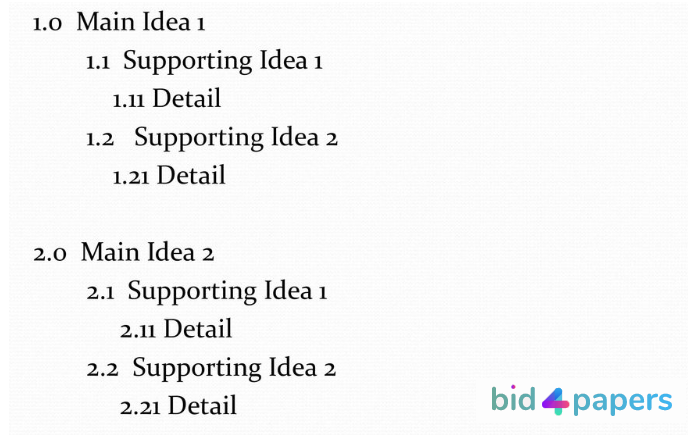
- Diagrammatic layout
Super useful for future recall, it represents the essential relationship between the man and supporting ideas. Here’s how to organize notes with this method:
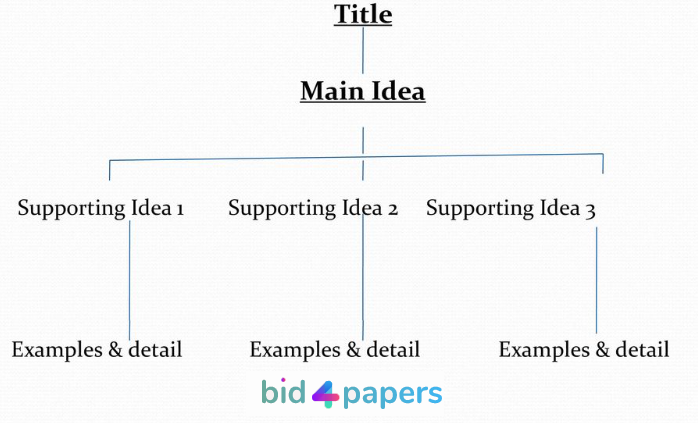
- Mind maps
This one is among the most popular ways to visualize research: You place the main topic at the center, craft the supporting details around it, and extend less important information further in branches. Like this:
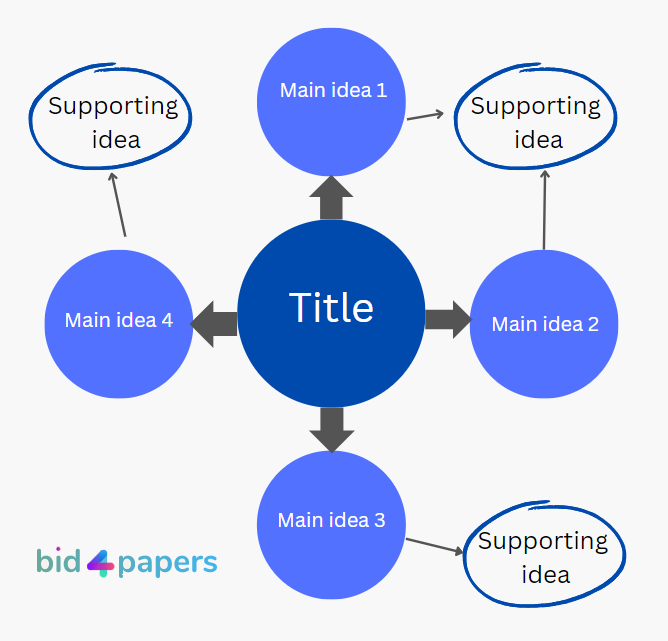
5 – Write a Thesis
In summary, a thesis statement goes for a one-sentence claim highlighting the original text’s main idea. It demonstrates that you understand the original.
Generating a thesis is critical, especially if you write a book summary. Our free online tool can make this process easier for you.
6 – Write a Summary Draft
Use your thesis statement as the first sentence of your summary. Remember that you write a short version of a larger work: Stick to the 1/4 length of the original.
Consider linking words to maintain the information flow, and remember that you write in your own words. Use a so-called “summarizing language” reminding the reader it’s a summary. Try phrases like “The author suggests,” “The article claims,” etc.
Avoid direct quotes; paraphrase, not plagiarize.
Stay objective: Describe, not evaluate or share your opinion about the work. Write a summary in the present tense.
What to include in a summary:
- An opening line listing the author’s name, work title, and overall idea
- Main points or ideas the author conveys. Avoid tiny details; there’s no need to provide every aspect of the original text in your summary
- A closing line where you restate the overview in one sentence
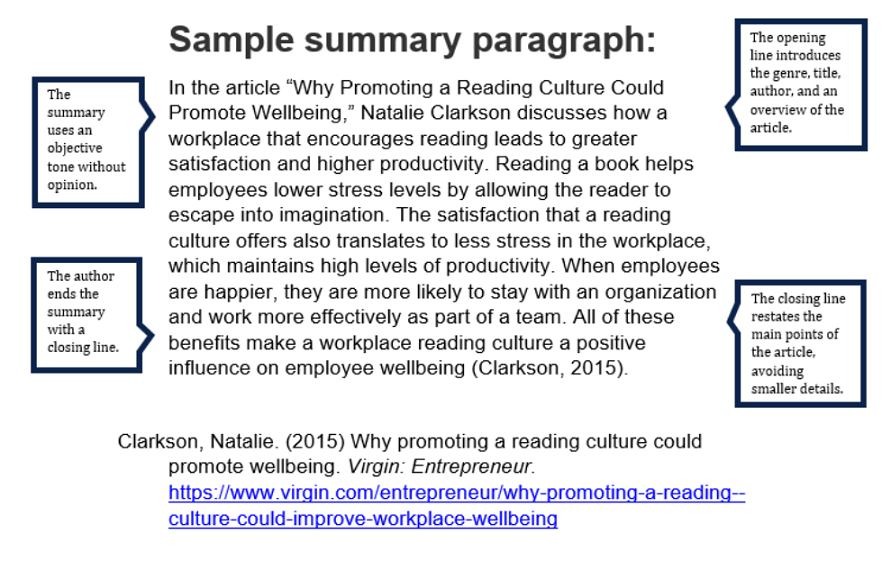
7 – Proofread and Revise If Necessary
Now that your summary is ready, do your best to edit it before submitting it to a professor. Reread the draft several times and make changes if necessary. Don’t hesitate to ask someone to check your summary and provide feedback.
Professional editing service is worth trying if you are still unsure if your paper is A-worthy.
The checklist to consider while revising:
- Your summary has a title.
- The summary is short.
- You’ve covered all the critical points from the original text.
- You’ve used your own words: There are no direct quotes or plagiarism.
- Your summary doesn’t include your own ideas, opinions, or interpretations.
Also, remember to proofread your summary to prevent tiny typos and grammar mistakes.
Four Types of Academic Summaries: Writing Tips
As you’ve already got it (we hope!), summaries can be different: descriptive and evaluative, super short or longer — they highlight the original work’s essence for the reader to understand the meaning without unnecessary details.
Speaking of the academic world, four main types of summaries exist:
- Summary papers
- Annotated bibliographies
- Academic notes
- Summaries within essays
Each of them requires slightly different things. Below are the details:
1 – Summary Papers
A summary paper is longer than other forms of summary: It reminds a descriptive essay where your entire work is a summary of the original text: an article, a book, or a report.
Your teacher can ask you to write a summary paper to see how well you understand a reading assignment. The point is to help you digest reading so you can tell about it in your own words.
While summary papers are longer than other types of academic summaries, you can describe more details there but still focus on the most critical ones. As a rule, this summary is 1/4 length of the original text. Thus, if you need to summarize the full book, your paper may be 3-4 pages long.
2 – Annotated Bibliographies
An annotated bibliography is a list of sources you’ve used for research, with a short paragraph about each one.
Annotations are more like evaluative summaries, requiring a specific style of writing. Here you’ll need to summarize the source and explain why it’s relevant and critical for your paper’s topic.
An annotation starts with a summary: You’ll have 2-3 sentences to represent the original work, so it matters to focus on the essential information it says.
Here’s our ultimate guide to help you: How to Write an Annotated Bibliography: Formats, Types, Steps
3 – Academic Notes
This type is about summarizing the original work (a lecture, a discussion, a lesson) in the form of personal notes.
You write academic notes for yourself, writing down the critical information a teacher says during a lecture. While it seems easy, it’s still about finding the balance between what to note and what to ignore.
Tips:
- Focus on what your professor writes on a board.
- Refer to a textbook: What does it summarize about the topic?
- Decide how often you’ll make notes: Will it be one point per minute or maybe one point per five minutes?
4 – Summaries Within Essays
It’s the most common type of academic summary: a quick one within the body of another assignment. For example, when you write argumentative or critical essays, you’ll need to introduce some sources to explain your arguments.
Such summaries are super short: 2-3 sentences for the reader to get an idea of the work before you move on to the specific parts that support your point.
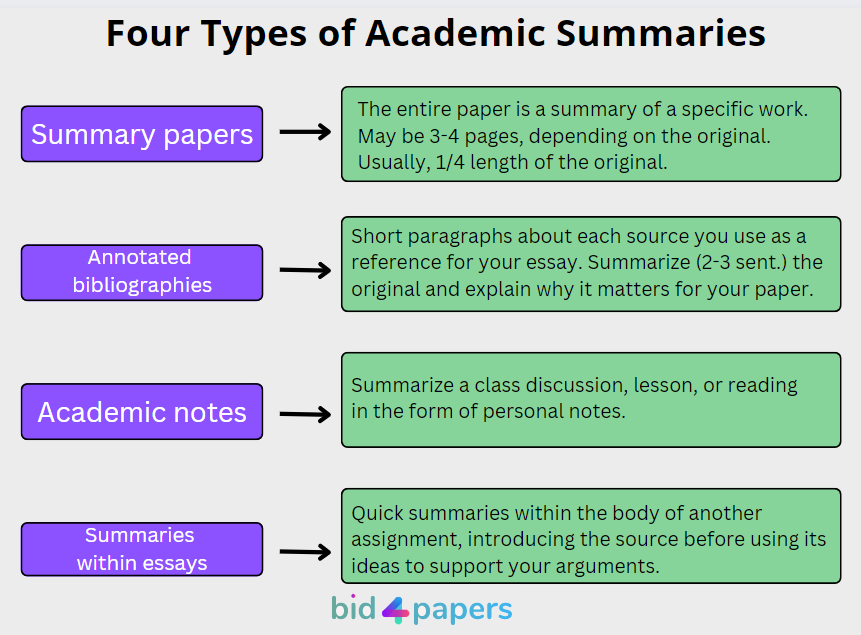
How to Format a Summary: Tips
Summaries don’t have any specific format. As a rule, it’s a paragraph including the introductory sentence, the original text’s main ideas, and the final sentence wrapping up (rephrasing) the main point.
Below are some writing tips on how to format a summary:
- Make it a paragraph.
- Start with a sentence specifying the original text’s title, author, and main point.
- Use your own words, don’t cite the original.
- Avoid sharing your thoughts or interpretations about the work you summarize. Use an objective tone.
- Specify critical sub-points the author used to support the main point. If you decide to quote them, mention the paragraph number after each point, thus specifying where it was in the original. (See the example.)
- Wrap up your summary in the last sentence: restate the main point.
How to format a summary: Example
In the essay, Santa Ana, author Joan Didion's main point is [state it here]. According to Didion, "[a sub-point here]." (para.4). She also writes about [a sub-point here]. Finally, Didion states that "[a sub-point here]." (para. 10) All of these make [wrap up, rephrasing the main point].
Frequently Asked Questions:
-
How long is a summary?
The length can range from a few sentences to several paragraphs, depending on the assignment type, the purpose of the summary, and the length of the original work itself. As a rule, summaries are 1/4 length of the original text.
-
How many sentences are in the summary?
If your summary is a paragraph, it will be around 5-8 sentences: an introductory one, a few ones specifying the author’s points, and a final one wrapping up everything.
-
What should a summary include?
A summary includes an introductory sentence with the original work’s title, author name, and overview; then comes 3-5 sentences specifying the work’s main ideas; finally, the last sentence comes: it concludes the whole summary, rephrasing the main idea of the original text.
-
What assignments involve writing a summary?
A summary can be a stand-alone assignment (a summary paper) when you write a descriptive essay on the material you’ve read. Also, summaries are present in annotated bibliographies, some academic papers to support arguments, presentations, and personal notes a student takes during a lecture or a class discussion.
-
How to format a summary?
Write a summary as a paragraph, using your own words and specifying the main ideas of the original text. The first sentence will include the text’s title, author, and overview. The following 3-5 sentences specify the core ideas, and the last sentence wraps up everything. Do your best to avoid personal thoughts, interpretations, or comments in a summary.
-
How to write a summary for an essay?
Read the original text and figure out the main idea (point). Start a summary with a sentence about the work’s title, author name, and main idea. For example, “In his essay, Inside Out, John Smith covers the problem of multiple personality disorder.” After that, write about the core points the author represents; conclude by rephrasing the main idea of the essay you summarize.
-
How to write a summary of an article?
Make your summary about 1/3 length of the article. State the main ideas, identify the critical supporting details, and express the article’s meaning. Avoid copying phrases unless you use a direct quotation; if so, mention the paragraph number from where the quote comes.
-
How to write a summary of a book?
First, ensure you make notes while reading: It will help you remember the characters and core points and then identify which ones to include in a summary. Focus on introducing the characters and establishing the setting in your summary’s introduction; write about the “problem” of the book in the body; end your summary with resolving the book’s problem.
-
Who can help me write a summary?
You can address social media groups or forums on writing to ask members to assist you and explain how to write a summary. Or, feel free to ask Bid4Papers professional writers: we are here 24/7 to improve your writing skills and help you get better grades.
